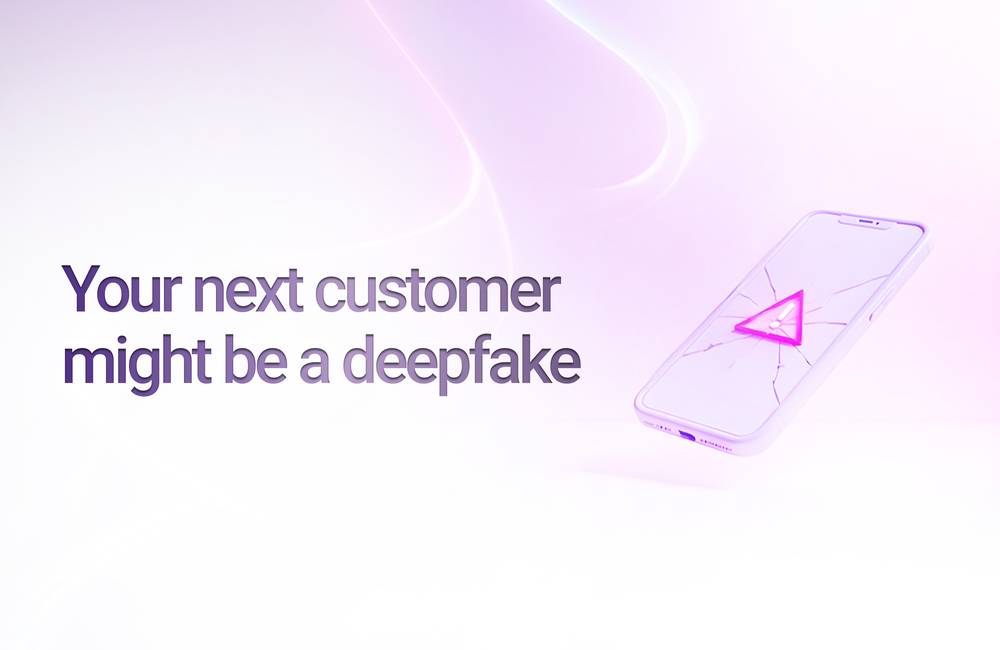The AI fraud boom: your next customer might be a deepfake Written on

TL;DR
-
AI fraud is happening now, using deepfakes to create fake customers.
-
These synthetic identities easily bypass basic security checks.
-
Your system needs advanced deepfake detection technology and real-time liveness checks to confirm a user is real.
-
Without this, your business is exposed to massive financial and reputation risks.
-
Investment in this technology is essential to maintain trust and adhere to standards like eidas.
The rise of AI fraud is not a future problem—it's happening right now, at scale. It’s highly likely someone has already tried to scam your business using a lifelike, yet completely fake, face. Maybe they succeeded. They could be inside your system right now, perfectly "verified" with a seemingly compliant KYC selfie, ready to siphon money, access services, or launder funds.
The chilling reality? That face doesn't belong to any real person. We are firmly in the age of synthetic identities, and it’s time to confront the awkward fact that your most trustworthy-looking new customer might be a "Frankenstein face" — a perfect image stitched together by a sophisticated algorithm with zero human conscience.
This is the AI fraud boom: it’s fast, cheap, and terrifyingly effective. If you are not urgently adopting deepfake detection technology, you are already playing catch-up.
The fraudster’s new toolkit: beyond simple hacking
Forget old-school phishing emails and simple password hacks. Today's fraudster is leveraging powerful, often open-source AI tools like “FaceFusion” or “DeepFaceLab.” They aren't typing code in a dark room; they are drag-and-dropping selfies into automated pipelines that churn out ultra-realistic videos and profile photos. These are the kinds of images your digital onboarding systems currently welcome without question.
Why steal an ID when you can simply generate a brand-new one that exists in no database and won’t trigger typical fraud flags? That's synthetic fraud 101. The only reliable defense is with deepfake detection technology that is rigorously trained, tested, and tuned to spot the subtle facial fraud anomalies that no human eye can catch.
Trying to rely on manual review is a losing battle. Your frontline staff cannot possibly outsmart a Generative Adversarial Network (GAN). They are not trained, nor are they capable, of spotting subtle pixel anomalies or detecting algorithmically perfect expressions. This isn't a training deficit; it's a critical infrastructure failure. Without robust deepfake detection technology, your verification process is based on blind guesswork.
Smile for the camera… Or don’t: the liveness problem
In a digital, fast, and remote world, a user’s face is the new authentication credential. And just like passwords, faces are now being stolen, forged, and manipulated with ease. Consider video-based Know Your Customer (KYC) procedures, where you ask a user to blink, turn their head, or say a specific phrase. This used to feel secure. However, modern AI can now generate convincing deepfakes that can blink on command, and even accurately fake shadows and light reflections. Unless you are using deepfake detection technology with real-time liveness detection, you are essentially rolling out the red carpet for a fraudster.
This is not a theoretical warning. Banks, fintech applications, gaming platforms, and even government services have all reported successful or attempted deepfake infiltrations. Businesses that have invested in cutting-edge deepfake detection technology are the ones who can genuinely sleep soundly. They are not just meeting basic compliance; they are establishing a trusted environment, which is becoming increasingly necessary for adhering to global standards like eIDAS for digital identity security.
Why detection is harder than you think
The challenge is this: spotting a weird blink or a choppy lip sync is ancient history. Today's deepfakes are incredibly smart, clean, and specifically designed to bypass traditional, basic checks. Effective, modern deepfake detection technology relies on complex analysis of biometric anomalies, texture inconsistencies, unique light reflection patterns, and frame-by-frame facial microexpressions. This is no longer about a human "feeling" something is off; it’s a high-stakes, machine-vs-machine battle where your system has to win every time.
If your platform relies only on basic face matching without embedded deepfake detection technology, it's merely a high-tech sign-in sheet with no real security lock. It looks good, but it offers zero protection.
The real cost of doing nothing
What are the consequences when a deepfake successfully signs up for your platform?
-
They may take out a loan or line of credit with no intention of repayment.
-
They could register countless fake accounts to launder illicit funds.
-
They might open a payment gateway account to process stolen credit cards.
-
They could use your "verified" platform to establish credibility for a much larger, future scam.
Now, scale that problem to hundreds or even tens of thousands of synthetic accounts. This is not isolated, one-off fraud; it’s scalable, industrial crime-as-a-service. Every time you allow a synthetic face through your system, your brand and reputation suffer a permanent loss of trust. The only viable path forward is to invest in best-in-class deepfake detection technology before criminals invest in using deepfakes to destroy your business.
What good detection actually looks like
In an industry flooded with buzzwords, "deepfake detection" is the new must-have claim. Many vendors simply slap the label on a basic facial recognition API, add a head-turn prompt, and call it security. That is fundamentally misleading. Face matching is not fraud prevention, and asking a user to nod is not the same as definitively proving they are a real person.
So, what does genuine deepfake detection technology require?
-
Passive Liveness Detection: It must work silently and invisibly in the background, without forcing users into awkward, choreographed movements. If your system still requires users to perform a "dance," it’s not equipped for the sophisticated fraud that already exists.
-
Frame-Level Analysis with Deep Neural Networks: The models must be trained on massive, proprietary datasets of actual deepfakes, not just lab-created synthetic anomalies. These systems are trained to spot subtle yet undeniable cues: inconsistent lighting, telltale skin texture artifacts, or the “plastic gloss” that even high-resolution fakes cannot perfectly hide.
-
Continuous & Rapid Updates: Deepfake technology evolves incredibly fast, and your detection system must evolve even faster. If your vendor isn’t pushing updates weekly, they are already behind the curve.
-
Hybrid Liveness Detection: For the most robust protection, you need a multi-layered approach that combines both passive and active signals. This adaptive strategy balances minimal user friction with maximum security, requesting an active check only when passive results are inconclusive or suspicious.
Deepfake detection technology that truly works doesn’t just sit on top of your KYC flow; it becomes your primary defense—a silent gatekeeper that spots fakes before they ever gain access. It’s not just about keeping fraud out; it’s about maintaining verifiable trust in your digital ecosystem, which is essential for compliance with standards like eidas.
The business case: why your CFO should care
If you still view this as merely a "compliance" concern, you are missing the bigger picture. Every single synthetic account costs your business money: in onboarding effort, support tickets, fraud losses, chargebacks, and irreversible brand damage. Each fake account chips away at your profit margins. Furthermore, the moment regulators focus on this (and they always do), you will need concrete proof that you deployed state-of-the-art measures to stop it.
Investing in deepfake detection technology is objectively cheaper than dealing with a major public scandal. It is cheaper than fighting a lawsuit. It is significantly cheaper than the immense cost of having to rebuild trust from scratch. This is no longer a "nice to have" security feature; it is mission-critical infrastructure for any business that relies on people proving their identity online.
Final thoughts: trust is your real product
Deepfake detection technology is more than a fraud block; it’s a tool for preserving the genuine human connection in your digital experience. It ensures that when a user smiles at the camera, it's a real person who exists and is engaging with your business in good faith.
The next time you onboard a customer, you need to ask a crucial question: are you welcoming a legitimate new user… or are you unknowingly shaking hands with a sophisticated, AI-generated identity? You absolutely cannot afford to be wrong.
Stop guessing and start detecting with YouLive by Youverse. Try our cutting-edge liveness detection and deepfake detection solution for free today and see the difference real security makes.






